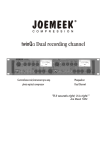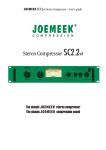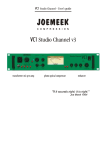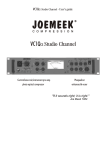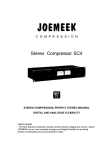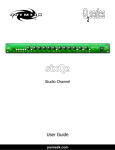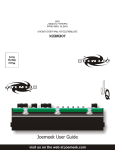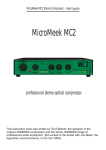Download SC2 - Joemeek
Transcript
JOEMEEK Tel Sales: 310-373-9129 Tel Admin: Fax: 310-373-4714 JOEMEEK 23775 Madison Street Torrance, California 90505 USA email: [email protected] web: www.joemeek.com It's assumed any engineer using this compressor will already be familiar with the practice of compression and limiting. These instructions are kept brief and to the point; the most valuable instruction is to plug it in and use it. JOEMEEK COMPRESSOR SC2 LIMITING AND COMPRESSION Why is the JOEMEEK different to a modern high tech. compressor limiter? It was designed as a stereo effects compressor rather than a 'leveling amplifier' as the early compressors was called. These are the basic definitions: . A LIMITER is a device which stops the output of a signal path going above a predetermined level. . A COMPRESSOR is a device which reduces the dynamic range of programmed material. A 'perfect' compressor is an amplifier where the input/output ratio is constant: So using a 2:1 compressor, increasing the input by 2dB gives a corresponding 1dB increase in the output. Early compressors which used variable mu thermionic tubes or photoelectric devices only approximated true compression over a limited range. They had a soft 'threshold' where compression started and held to a predictable ratio up to a certain level, and then they returned to a more linear amplification allowing transients through. This is in stark contrast to modern VCA compressor/limiters where designers thought it 'sensible' to combine the functions of compressor and limiter and to 'stonewall' any and all signals above a certain level. The musical effect is that (I know I'm over simplifying) VCA compressors sound muddy and flat, while old compressors sound lively and retain sparkle. ITS HORSES FOR COURSES, a good VCA compressor limiter will do a good job making medium wave radio sound a bit louder and protecting a radio transmitter from exploding, but it is a poor tool for making a voice track stand out. Page 1 THE COMPRESSOR The JOEMEEK compressor was designed to use the apparent deficiencies of the older technology providing a powerful artistic tool for the creative engineer. . Joe Meek used to say, "If it sounds right, it is right!” To a lot of his contemporaries he went way over the top with overloading the record electronics on his 'Lyrec' recorder, and swathing his less-than perfect singers in bathroom echo and reverb, but his artistic use of non linear compression was masterly. CONNECTIONS. Inputs and outputs are balanced line level but can be operated unbalanced without loss of quality. . If using unbalanced circuits, it is essential to ground the unused audio connection, i.e.; pin 3 on the XLRs or the 'ring' on the jacks. The XLR and standard 1/4 inch jack connections are in parallel so should not be used at the same time. Inputs are high impedance and outputs are low impedance (as is normal for all good outboard equipment). OPERATION. Connect inputs and outputs and plug in mains cable NOTE: THERE IS NO POWER ON/OFF SWITCH. When the unit is powered, the meter needle will be at '0' and either the red or the blue indicator will be on. Compression is active when the blue light is on. Set the controls as follows: SLOPE to number 3 IN/OUT SWITCH to 'IN' (blue light) ATTACK to fast; full anti-clockwise. RELEASE to medium; halfway REAR PANEL OUTPUT GAIN CONTROL set at or near full. Page 2 SC2 CONTROLS . Feed some program material into the unit and set the 'STEREO INPUT GAIN' control to about number 5; this will correspond to about 10dB gain. . Set the output (rear panel) to match the equipment being driven. (professional studio equipment is normally +4 or 0dB. less expensive equipment is often 10dB) . Turn up the 'COMPRESSION' control slowly and, if there is sufficient audio signal, the meter will start to indicate compression by the needle moving downwards. The compressor should now be working and your ears can take over. CONTROL EXPLANATIONS. There are two main gain controls on the compressor; the input gain control on the front panel, and the output gain preset control on the rear panel. The input gain control is a simple stereo ganged control that sets the audio gain of the front end amplifier. At maximum, the gain of the unit is about 20dB. So if you set the gain to say 10dB and wind in compression until the in/out switch tells you that the output is the same, you have 10dB true compression. The output gain preset control is to set the output to a comfortable level for the equipment it is feeding into. CAUTION; the compressor has gain, and a high output capability. If you hear a sign of overloading it’s likely that your mixer insert point is being overdriven. It’s very unlikely that you are overdriving the compressor: Try turning down the output volume (rear panel). 'SLOPE' this control alters the ratio of compression. In practice, '1' is very gentle compression while '4' can give severe 'pumping' effects. I find that '1' or '2' is right for voice and for overall effect, while the higher numbers are better for instruments. Page 3 PROBLEMS SC2 'COMPRESSION' simply adds gain to the compression sidechain. In simple terms this changes the 'threshold' of the compression although with this compressor the 'threshold' is not clearly defined; the compression starts very gradually and the compression ratio changes with program content and amplitude. For practical purposes, winding up the compression control increases the amount of compression. In use you will find that musically, all controls are interrelated. 'ATTACK' sets the time that the compressor takes to act. At minimum (fastest) it's possible to make it 'overshoot' on some percussive program material: This means that the compression electronics are driven hard before the gain has been controlled by the light cells. The cells catch up and over compress momentarily giving a tiny dip immediately following the start of the 'note'. This is best demonstrated by using a drum track and setting the slope to '4', and attack and release to fastest. Used sparingly this can contribute to musical drive. Slower attacks are used where the compression needs to be less obvious. 'RELEASE' sets the time during which the path gain returns to normal after compression. Generally, the longer the time, the less obvious is the compression. PROBLEMS. 1) Got signal going through but no compression? In/out switch? Is there enough volume level going in? Is your stereo signal in phase? (If it's exactly out of phase, the compressor will not work). 2) Its noisy. The compressor itself is extremely quiet, but by definition compressors raise the level of quiet passages; this also means that if there is noise on the original, there will be more noise on the compressed signal. It's a compromise. Page 4 3) It distorts. No it doesn't! Distortion inside the compressor is virtually impossible; however it is possible to drive your insert point too hard. Try reducing the input gain control and winding up the compression a bit more. 4) I can't make the compression gentle enough! It takes practice. The setting of the Attack control close to fastest is quite critical, as is the compression control. 5) It won't pump hard enough! Again, it takes practice getting the gain control in the right range. Set the slope on '4' and the attack and release at minimum, and then don't drive it too hard. Work the input gain and the compression controls until its right. 6) There's a terrible click on 'in/out' When the switch is in the 'out' position, the whole unit is by-passed so that there is absolutely NO electronics in the path. On some insert systems; particularly unbalanced ones, there is going to be a click. Page 5 ABOUT THE COMPRESSOR SC2 THE JOEMEEK COMPRESSOR; WHAT IT DOES. Anyone who has tried to record a human voice in the simplest possible way has found that the dynamics of real world speech and music are impossible to handle with a 'linear' recorder: Even if the signals do not overload, the final result is a recording that seems to be thin, quiet and too wide in dynamic range. Early analog tape recorders had a built-in answer to the problem; slightly overloading the record channel produced (predominantly) 2nd order harmonic distortion and some volume compression. This made recordings sound 'warm' and reduced the problems of dynamics. Unfortunately (1), modern recording mediums don't react that way; they produce an accurate reflection of the input with all it’s built in problems. Most thinking engineers know of these problems and correct with the use of equalizers (to change the psychoacoustic distance from the microphone), limiters (to reduce dynamic range at the louder end) and enhancers (to sparkle it up). And then find that it is extremely difficult and time consuming to get a warm and cozy sound**. Joe Meek, in common with all engineers, experimented with the limited facilities of the time (1960 - 1965) and came up with a way of enhancing the 'tape bend’ effect with compression. The compressor he used was primitive in the extreme, but coupled with the compression distortion provided by the valve tape machines he had, the result was voice and music sounds that were unique and sold records by the million. I had to make some significant improvements in the way the early compressors worked to make the JOEMEEK acceptable to today's engineers, but now that they are in general use in top studios all over the world, the con census is that the sound is right, and really does recreate the warmth and power of the old equipment without the side effects. .. The classic way is to use a U47 or similar large diaphragm capacitor microphone; which in itself 'distorts' the sound with complex high frequency phasing across the diaphragm and some 2nd order distortion from the amplifier tube. Page 6 SAFETY There are probably hundreds of types of compressor limiters on sale in the world, all struggling for a place in the market with extra knobs and facilities and all missing the fundamental point, that a compressor is there to produce a psychoacoustic effect of power and dynamics, and not to perform any protective function electronically; it's a creative tool. The JOEMEEK recreates the dynamics of the old analogue tape and compressor combination. And yes; it is entirely possible that one day this algorithm could be written for a digital processor but would it be as easy to use? REGULATIONS AND SAFETY. The JOEMEEK Compressor has been designed and built to conform to all known safety requirements in the world. Within the European Union the Compressor easily meets the requirements for electrostatic and electromagnetic emissions, and conforms to all safety requirements of the European Common Market. The 'CE' symbol on the rear of the unit indicates compliance. In the United States of America the compressor complies with UL requirements. Page 7 POWER SC2 POWER SELECTION JOEMEEK Compressors VER 1.07 and later, are fitted with a mains voltage selector for easy change of input voltage. The fuse carriage can be pulled out and rotated to select to the local power voltage. In the '110' position, the unit will operate between 95 and 125V AC. In the '230' position, the unit will operate between 210 and 240V AC. The fuse can remain at 500mA for both ranges. POWER EARTH (GROUND) CONNECTION The center (ground) pin of the IEC power connector is connected to the steel chassis of the compressor. The Audio ground is not connected to chassis. The power system is double insulated throughout so that power ground may be lifted off if required without affecting safety in any way. Page 8 HINTS TIPS ON USE. Some handy hints from some world class users: VOICES. The compressor adds stability and depth to solo voices, it allows you to use less of the 'enhancer' and still retain the sparkle. Over compression with fast attack times on voice will change the apparent tonal quality so listen carefully! Try recording first with a little compression, then adding more at a different release time on the mix. PIANO. Tricky, use it very gently unless you want unusual effects! PERCUSSION. The danger is to use it too much too early, save heavy use for the mix. GUITARS. Wind it on! The depth and sustain make it a must. ORCHESTRAL. A little light 'tightening' of an orchestral sound will make it more present and warmer sounding and add body to string sounds. ON THE MIX. Remember that big compressed sounds are a balancing act; if any instrument or sound in the mix is suddenly louder than others, it will kick down the level of all the rest. As the sound stays bright and 'present' with this compressor, it's possible to go much heavier; but the initial balance gets more critical! Experiment with the attack control. GROUP RECORDING. Try compressing the backing but leave the bass outside the compression and compress it separately. GENERALLY, because the compressor is so extremely quiet and free of any nasty distortions, its quite OK to use it both on individual tracks, and on the mix, so I tend to use it individually on almost everything just to gain some individual warmth, then use it again on sub groups in the mix; so it pays to have more than one! Thanks for buying the compressor: I'm now enjoying hearing its characteristic sound on records and productions from all over the world. Page 9 WARRANTY SC2 WARRANTY. In the unlikely case of a breakdown, please return the unit in its original packing through the supplier. The unit will be attended to immediately and returned to your supplier. If any breakdown occurs (excluding physical mistreatment) within 12 months of purchase no charge will be made. DECLARATION OF CONFORMITY. This analogue audio processing equipment conforms to the standards and requirements of the European Economic Community. The EC Harmonized standards that have been applied are; a) Electrical equipment (safety) Regulations 1994 (S.I. 1994/3260) b) Electromagnetic Compatibility Directive (89/336/EEC) incorporating (S.I. 1992/2372) CE 96 Distribution by PMI Audio Group 23775 Madison Street Torrance, CA 90505 Page 10












